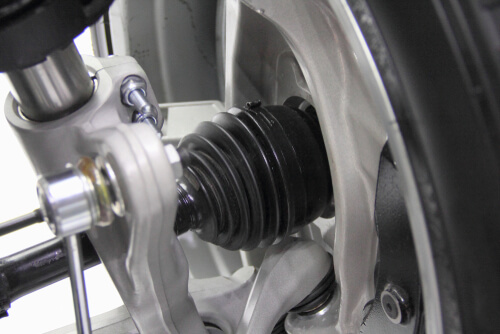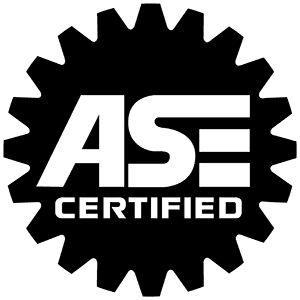CV Joint Replacement and Drive Shaft Repair
The CV joint (constant velocity joint) and drive shaft are two essential components in a vehicle’s drivetrain system. The CV joint is found on the outer ends of the front axle half-shafts of your vehicle. It allows the front wheels to move up and down while maintaining a constant speed of rotation from the engine.
The drive shaft transmits power from the transmission to the rear axle in rear-wheel drive vehicles. It rotates at high speeds inside a protective metal housing to safely transmit engine power to the rear wheels.
Together, the CV joints and driveshaft form the crucial physical link between the engine and wheels that enables your vehicle to power itself down the road.
However, miles of travel can lead to CV joint replacement and drive shaft repair. Kwik Kar Auto Services has locations across Texas that can help you repair and replace your old joints and ensure your ride stays smooth for miles to come.
CV Joint Repair
Do you hear clicking or popping noises when turning, especially at low speeds? This is one of the classic warning signs of a worn CV joint. Excess vibration coming through the steering wheel at highway speeds can also indicate CV joint problems.
If ignored, the CV joint can become damaged to the point where it separates, leaving you with a stuck front wheel drive shaft.
When repairing a CV joint, find an experienced mechanic that you can trust. CV joint replacement includes dismantling, reassembly, proper lubrication, and tried-and-true sealing techniques.
Our Texas mechanics specialize in drivetrain and suspension repairs, and have worked extensively on CV axles and joints.
Reach out to our Dallas-Fort Worth, Houston, or Austin Kwik Kar with a garage for CV repairs. Our certified mechanics can repair and replace your CV joints without complications and get you back on the road at a fair price.
Drive Shaft Balancing and Repair
Your drive shaft transmits torque from the car’s engine to its back wheels. It’s critical to keep your drive shaft balanced because it has a significant impact on how well your vehicle operates at high speeds on the road.
An unbalanced driveshaft can cause noticeable vibration at certain speeds as it rotates. These vibrations can put extra stress on transmission components, U-joints, and motor/transmission mounts over time, leading to premature wear and failure.
An unbalanced driveshaft causes power losses as extra engine torque is needed to overcome the shaking forces. Balancing allows maximum power transfer through the drivetrain and ensures smooth rotation.
Balancing your driveshaft is an easy way to reduce vibration, noise, and wear for improved drivetrain performance and component life.
If you’re experiencing a little shake in your ride, it’s time to stop in at a Kwik Kar near you. Our mechanics quickly identify driveshaft problems and repair or replace car parts before further damage occurs to your vehicle components.
What’s the Difference between CV Driveshafts versus U-Joints?
The driveshaft is a solid metal shaft that transmits power from the transmission to the differential in rear-wheel drive vehicles. Universal joints, or U-joints, are located at either end of the driveshaft and allow it to operate at changing angles as the suspension and drivetrain move.
U-joints serve as flexible couplings that allow smooth power transmission from the gearbox to the axle even as their relative angles shift.
The driveshaft focuses on constant high-speed rotation, while U-joints accommodate the angles and changing geometry as you maneuver the curves of the open road.
Prevent CV Joint Failure
There are a few key maintenance steps you can take to help prevent CV joint and axle failure.
Regularly inspect the CV boot. Small cracks or tears in the boot should be repaired immediately before dirt and water can damage the joint. Go to a Kwik Kar near you to replace any boot that is split or deteriorating.
Another way to ease up on your joints is to avoid overloading your vehicle. Carrying excessively heavy loads in the vehicle puts more strain on CV joints. Overloading can lead to premature wear. Be mindful of cargo weight limits.
Finally, we recommend inspecting your suspension. Worn suspension components like ball joints can alter the CV joint angles, leading to accelerated wear. An alignment check or suspension inspection at the first sign of clunks or vibration can help avoid long-term damage.
CV Joints and Driveshafts FAQ
Is a drive shaft the same as a CV joint?
While both keep your vehicle moving, there is a difference between driveshafts and CV joints. Your driveshaft transmits power from the engine to other drivetrain system components. CV joints allow your vehicle to maintain speed without increasing friction throughout the components of your vehicle.
How does a driveshaft work?
The driveshaft is a critical component in a rear-wheel drive vehicle’s drivetrain. It transmits rotational power from the transmission to the differential.
As the transmission output shaft turns, it rotates the driveshaft, which spins inside a protective enclosure. The universal joints allow the driveshaft to operate smoothly at various angles as the suspension and drivetrain components move in relation to each other.
Essentially, the spinning driveshaft carries the power from the engine and transmission through the u-joints and shafts to turn the differential, which then ultimately drives the rear wheels.
How much does it cost to replace a CV drive shaft?
You can purchase a replacement shaft for between $60 and $150 dollars each. It usually takes between 1 and 3 hours for replacement and labor can cost between $150 and $350 dollars.
What happens when a CV shaft goes bad?
Since CV shafts deliver power from the transmission to the front wheels, when one goes bad, you’ll immediately notice a loss of drive to that wheel. The inner CV joint contains caged ball bearings that can wear out over time, causing vibration at high speeds.
The most common symptom of a bad CV shaft is clicking or clunking when turning.
If you notice these issues, make an appointment at a Kwik Kar near you. We believe it’s best to replace the damaged CV shaft promptly to restore proper power transfer and prevent further drivetrain damage.
Does a new drive shaft come with a CV joint?
CV joints are part of the drive shaft. Therefore, a new drive shaft comes with a CV joint.
Why do I hear clicking or popping sounds when I turn my steering wheel?
These noises commonly mean that you have a worn CV joint. As your axle bends with the wheel, the bearings within the CV joint are what you hear popping in and out of place as the wheel moves.
Why is my steering wheel vibrating?
A vibrating steering wheel typically indicates an issue with your vehicle’s wheel balance or suspension components. If the vibration occurs at high speeds, the most common cause is a wheel that is out of balance.
Another possibility is worn suspension parts like ball joints, control arm bushings, or shock absorbers. As these components wear out, it allows more movement and vibration to transfer through the steering components.
In some cases, a bent rim or separating tire tread can lead to steering wheel shake. The next time your steering wheel vibrates, stop in at a Kwik Kar near you to have a mechanic inspect the wheel bearings and suspension on your vehicle.

CV Joint Repair
Whether you need CV joint repair or driveshaft replacement, the team at Kwik Kar near you is ready to help you get back on the road.
Don’t let vibrations and odd noises become a larger problem. Our certified mechanics can help you keep your car in good condition with fair prices and quick auto repair or maintenance needs like oil changes and tire rotations.
Contact us to learn more about what Kwik Kar Auto Services near you can offer.
Additional Auto Repair Services Available at Kwik Kar
If you need more than muffler repair, we offer more maintenance and repairs at our neighborhood Kwik Kars, including (alphabetical):



